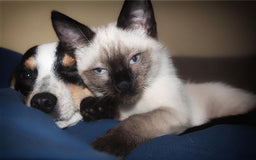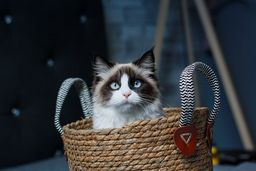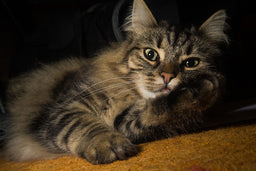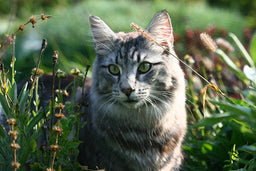Persian cats’ colours and patterns
The friendly Persian is famous for their luscious coat that comes in various colours. With their gentle personalities and good looks, they are perfect companions for any household.
According to the CFA (Cat Fanciers Association), these adorable fluffy felines are divided into seven different colour divisions for easier categorisation. Cat parents can take their pick of colours and patterns—from solids to tabby.
Learn about different Persian cat colours and other traits specific to this breed. We’ll also explain how to keep their colourful coats healthy and shiny with the best diet.
What are the Persian cat colours?
Most breeds, including Bengals and Maine Coons, come in various recognised and unrecognised colours. When it comes to Persians, TICA (The International Cat Association) accepts all of their colours.
The seven divisions of Persian cats are:
- Solid
- Silver and golden
- Smoke and shaded
- Tabby
- Particolour
- Bicolour
- Himalayan
Solid
Solid Persian kitties have a single coat colour uniform throughout their body. They come in the following colours:
- White
- Black
- Blue
- Chocolate
- Cream
- Lilac
- Red
Blue, black, and white ones are common, while chocolate and lilac variants are much rarer.

I wonder if they’d bathe me less if I were some other colour… Life isn’t fair!
Source: Mariam Soliman
Silver and golden
Silver and gold are extremely popular colours for Persians. They are considered exquisite and rare and come in two different variants:
- Chinchilla—white with black tips
- Shaded—uniform black shading over the darker parts
Smoke and shaded
Persians with smoke, aka shaded coats, are mesmerising because their coats seem solid-coloured while they’re standing still, but once they start moving, the bright roots begin to show, creating a smoke-like appearance.
This division includes two cameos in four different colours, as seen in the table below:
|
Colour |
Description |
|
Cameo |
Red tipping with a white undercoat |
|
Cream |
A white undercoat tipped with cream |
|
Tortoiseshell |
Black tipping with well-defined patches of red-tipped hairs |
|
Blue-cream |
Blue tipping with well-defined patches of cream-tipped hair |
Tabby
Tabbies come in various colours, including:
- Blue
- Blue-silver
- Brown
- Cameo
- Cameo-cream
- Cream
- Red
- Silver
There are three different colour patterns, and they are presented in the following table:
|
Persian pattern |
Characteristics |
|
Classic tabby pattern |
Bull’s eye markings on the sides |
|
Mackerel tabby pattern |
Narrow pencil-like stripes circling the body |
|
Patched tabby pattern |
Mackerel or classic tabbies with red patches (they don’t come in red, cream, or cameo) |
Particolour
Particolour Persians come in four different shades, including:
- Blue-cream
- Lilac-cream
- Chocolate tortoiseshell
- Tortoiseshell

We don’t know what particolour means, but we love a good party!
Source: Reba Spike
While blue- and lilac-cream colours are muted and soft, torties have a vibrant and eye-catching appearance.
Bicolour
Bicolour Persians can be:
- Van Persians—White coats with spots in two colours (usually on the head, legs, and tail)
- Classic Persians—White bellies and legs, with a different colour on the top
- Calico Persians—Patches of black and red scattered over a white base coat
These patterns come in the following colours:
- Black and white
- Blue and white
- Red and white
- Cream and white
- Chocolate and white
- Lilac and white
- Calico
- Chocolate calico
- Lilac calico
- Dilute calico
Himalayan
While some consider the Himalayan a separate or sub-breed, the CFA sees them as a division of the Persian breed. These kitties are a mix of Siamese and Persian cats, created in an attempt to achieve the Siamese colour pattern in Persians.
Himalayans’ base coats come in various shades, ranging from white to fawn, while the points on their faces, ears, and extremities are of different colours.
What about the Persian cat eye colour?
Besides their gorgeous coats of different colours and patterns, Persian cats are known for their large, protruding eyes that perfectly complement their fur. Depending on which of the seven aforementioned divisions your Persian belongs to, their eyes will be:
|
Coat colours |
Eye colours |
|
Solid |
Solid-coloured Persians can have three different eye colours (copper, blue, or one of each) |
|
Silver and golden |
Green or blue-green eyes with black rims |
|
Smoke and shaded |
Copper |
|
Tabby |
Silver tabbies can have green, hazel, or copper eyes, while other tabbies’ eyes come only in copper |
|
Particolour |
Copper |
|
Bicolour |
All bicolour Persians have copper eyes, except for the silver tabbies with white who can be green- or hazel-eyed |
|
Himalayan |
Bright blue eyes |

They might think my coat colour is bad luck, but they cannot resist my eyes!
Source: Dan Wayman
Are there specific techniques for taking care of different Persian cat colours?
Regardless of their colours and patterns, a Persian cat’s care regimen should always be the same. To ensure a soft, mat-free coat and an overall healthy feline, you should:
- Groom them regularly
- Feed them a high-quality diet
The perfect grooming routine for your Persian
Persians are high-maintenance kitties. They need to be groomed every day to keep a silky, shiny coat. Skipping sessions will make their coats matted and greasy, potentially leading to hair loss, skin rashes, and hairballs. They aren’t hypoallergenic, so allergic cat parents must take this ritual seriously.
The essentials of Persian grooming are:
- Brushing—Brush your cat daily using a wide-toothed comb to get through the thick double-layered coat and detangle it if needed
- Nail clipping—If your Persian spends all their time indoors, trim their nails every two to three weeks to compensate for the lack of friction they would otherwise get outside (friction helps them file their nails). You should also get a scratching post to mimic the outside conditions
- Bathing—Persians despise water, so you shouldn’t bathe them too often—every two months will suffice. If they get too dirty and matted during outside play, you might need to bathe them more frequently. Introduce baths early in the kittenhood to get your Persian used to them
- Eye and ear cleaning—Persians have flat faces, making their eyes super sensitive and prone to excessive tearing, which could irritate the skin around them. Clean their eyes and ears often using cotton balls and warm water or a vet-approved solution
- Teeth brushing—Because of their distinctive anatomy, Persians are prone to teeth loss and gingivitis. Brush their teeth daily and give them healthy dental cat food to prevent dental issues
The best food for your Persian's coat
Your Persian’s diet plays a massive role in their overall health and coat quality, so make sure you feed them high-protein, nutritious meals.
To maintain their shiny, colourful coats, Persians need a diet closely resembling their natural eating habits. Since they’ve been domesticated, cats no longer hunt mice, rabbits, birds, and frogs to survive. They have become more sensitive to raw meat and need a meal plan that’ll provide all the essential nutrients without the potential risks that come with a raw diet (Toxoplasmosis, Salmonella, E. coli, Listeria monocytogenes, and Campylobacter).
The crucial ingredients the cat food you pick should contain are:
- Animal protein
- Animal fat
Animal protein
Cats need essential amino acids, such as taurine and arginine, which they can only get from meat and fish. Plant proteins are inadequate because cats cannot break them down, so vegan and vegetarian diets won't make your kitty thrive. Animal protein will:
- Promote hair growth
- Help with building muscle mass
- Support proper organ function
Depending on the biological value (BV) of a particular ingredient, your cat will metabolise it more or less efficiently. Check the BVs of the most common protein sources in the table below:
|
Protein type |
BV |
|
Animal protein: |
88%–98% |
|
Vegetable protein: |
45%–68% |
Your Persian’s coat is made up of 98% protein, so their diet needs to contain ample amounts of it to keep their fur healthy.

What’s for dinner, hooman?
Source: Dan Wayman
Animal fat
Animal fat contains fatty acids that help improve:
- Vision
- Reproductive health
- Immune system
- Skin and coat
Cat food with moderate amounts (no more than 20%) of animal fat helps regulate your Persian’s inflammatory healing response and keeps their coat and skin healthy.
Hydration is essential
Dehydration can lead to dull and matted fur, while the skin could become dry and prone to tears. Since Persians hate water, you should find a way to meet their hydration needs through their diet.
Wet food is a much better choice than kibble since it’s typically made up of more than 75% water. You could mix dry food with broths and soups to increase its moisture content but be careful not to do it often because kitty biscuits are usually high in calories and contain subpar ingredients. Canned food has everything your Persian needs for health and longevity.
What to keep out of your Persian’s meals
Knowing which ingredients to avoid is crucial. Steer clear of products containing:
- Grains, cereals, and sugar—These ingredients are filled with carbs, which felines can’t digest properly. A high carb content can lead to weight gain and other related issues, such as diabetes and heart problems
- Unknown meat sources—Products containing animal byproducts or meat derivatives can lead to gastrointestinal issues, allergies, UTIs, and immunosuppression, which will affect your fluffy friend's coat and general health
How can Untamed help?
Our products have the ideal ratio of all the necessary nutrients needed for a healthy and happy feline. Here are the primary benefits of Untamed:
- Massive amounts of animal protein
- Vet-formulated recipes
- Ethically produced cat food
Massive amounts of animal protein
Untamed contains twice as much protein as most other cat food products.
All our jellies and gravies are made with human-grade meat and fish, guaranteeing that even the fussiest of Persians, who usually say no to wet food, won’t resist the temptation.
Vet-formulated recipes
Our recipes are made in collaboration with vets to ensure your cat gets all the essential nutrients in each mouth-watering meal.
Untamed will help even notoriously sensitive Persians avoid diet-related problems, including:
- Stomach sensitivity—Our products are free from any known allergens, while super sensitive kitties can try our single-source-protein meals
- Weight issues—High in animal protein, moderate in animal fat, and free of any useless ingredients, Untamed cat food will help prevent weight gain
- UTIs, cystitis, or bladder stones—Our canned food contains enough moisture to help your Persian get rid of toxins and stay hydrated throughout the day
Untamed is suitable for kitties at any life stage, including:
- Kittens who are weaning and developing rapidly
- Pregnant queens in need of more energy for their kittens
- Adult Persians dealing with kidney issues
- Chubby and lazy neutered males
- Seniors struggling with sudden weight loss, tooth loss, or lack of appetite
Ethically produced cat food
Our goal is to keep the planet a safe place for kitties and their cat parents, so we:
- Cooperate with cruelty-free, sustainable suppliers
- Package our food in 100% recyclable materials
Try Untamed and witness your Persian’s coat shine and their overall health improve.

Untamed will keep your Persian’s coat healthy and shiny!
Image (c) Untamed
How to get Untamed
Getting nutritious and tasty cat food delivered to your door has never been easier. Order our cat food online in three easy steps:
- Tell us about your Persian
- Customise your cat’s meal plan
- Order your initial trial pack
Your work is done. Sit back and relax because our cat food subscription includes:
- Free one-day shipping
- Monthly supplies delivered to your doorstep
- No-fuss modification of orders
- No-questions-asked cancellation policy
Cat parents whose Persian’s have made the transition to Untamed have reported the following improvements:
|
Timeline |
The Untamed effect |
|
After a week |
|
|
In two months |
|
|
Within four months |
|
|
Life-long |
|



